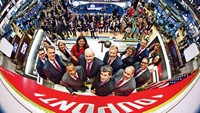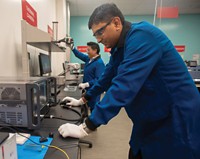Advertisement
Grab your lab coat. Let's get started
Welcome!
Welcome!
Create an account below to get 6 C&EN articles per month, receive newsletters and more - all free.
It seems this is your first time logging in online. Please enter the following information to continue.
As an ACS member you automatically get access to this site. All we need is few more details to create your reading experience.
Not you? Sign in with a different account.
Not you? Sign in with a different account.
ERROR 1
ERROR 1
ERROR 2
ERROR 2
ERROR 2
ERROR 2
ERROR 2
Password and Confirm password must match.
If you have an ACS member number, please enter it here so we can link this account to your membership. (optional)
ERROR 2
ACS values your privacy. By submitting your information, you are gaining access to C&EN and subscribing to our weekly newsletter. We use the information you provide to make your reading experience better, and we will never sell your data to third party members.
Business
The New Dow
After a painful year, company says it has the portfolio it needs for unprecedented expansion of its business
by Alexander H. Tullo
December 7, 2009
| A version of this story appeared in
Volume 87, Issue 49

To hear Andrew N. Liveris, the chief executive officer of Dow Chemical, tell it, the agony the company suffered this year was like the pangs of childbirth. The controversial acquisition of Rohm and Haas, coming amid the worst economic crisis since the Great Depression, tested Dow’s financial limits. But it was also the most important step in Dow’s rebirth as a company more focused on the Erlenmeyer flask than on the ethylene steam cracker.
Liveris was master of ceremonies at Dow’s investor day event last month in New York City, where he beamed about surviving the onslaught with cost cutting and divestitures. The Rohm and Haas acquisition that Dow bet the farm on, he heralded, has launched a new era of growth.
“In the face of one of the most difficult operating environments in a generation, we accomplished exactly what we set out to,” Liveris told reporters. “We diligently managed our finances to provide more flexibility and stability. And strategically, we put together the critical pieces that created this earnings powerhouse.”
Such events are called “dog-and-pony shows” for a reason: They are elaborate sales pitches. In this one, Liveris was selling a new Dow to investors. “This is not your father’s or mother’s Dow Chemical Company,” he told analysts and investors earlier in the day, using a phrase borrowed from a 1980s Oldsmobile slogan.
The location of the event, an old Bowery Savings Bank building repurposed by the upscale restaurant chain Cipriani into a plush locale for corporate shindigs, underscored the rebirth theme. The ballroom was lined with posters about solar power, lithium-ion batteries, and other technologies that Dow would prefer to be known for, rather than polyethylene plants and chlorine electrolysis units.
It stands to reason that Liveris wanted to put on a show. Events both inside and outside Dow’s control turned 2009 into one of its most trying years. The company had planned to use about $7 billion in proceeds from the formation of a global chemical joint venture with Petrochemical Industries Co. (PIC) of Kuwait to help pay for its acquisition of Rohm and Haas, announced in July 2008. The $18.8 billion price tag represented a hefty premium for the specialty chemical maker.
Then came last year’s financial crisis, and the intertwined deals started unraveling. In December, the Kuwaiti government canceled the PIC deal. Dow was left with a $13 billion bridge loan, meant to be a temporary stopgap, as the only way to pay for Rohm and Haas. The company faced the prospect of declining credit ratings and even defaulting on its debt. Liveris wanted more time to put Dow’s financial house in order. Rohm and Haas’s board insisted on completing the deal on time and dragged Dow to court. But on the day the trial was to begin, the companies agreed on new terms and inked the deal.
Dow had to scramble to pay the price. It sold $3.4 billion in assets to raise cash and initiated aggressive cost cutting. It even cut its dividend for the first time in 97 years.
Liveris said Dow has “fixed” its problems and can now focus on the future. The company has managed to pay off the bridge loan. And Liveris said that it has the portfolio it needs to expand revenues by more than 10% annually and increase earnings from the 44 cents per share reported in the first three quarters of this year to more than $4.00 annually by 2012.
The most important element of the growth will be Rohm and Haas, which, Liveris noted, has “by itself revitalized our portfolio and given us fantastic growth opportunities.” The old Rohm and Haas makes up about 75% of Dow’s new Advanced Materials Division, which in turn represents more than 20% of Dow’s roughly $46 billion in annual sales.
About half of the Advanced Materials Division is electronic and specialty materials, a business in which Dow had attempted to gain a foothold for years. The former Rohm and Haas was a world leader in chemical mechanical planarization and photolithography materials. The division’s new coatings and infrastructure business marries Rohm and Haas’s expertise in materials for architectural coatings with Dow’s in industrial coatings.
With the integration of Rohm and Haas comes cost cutting. Dow’s goal is to eliminate some $2.5 billion in annual costs by the end of next year. The company has thus far cut $1.4 billion, 62% of which is from the Rohm and Haas acquisition.
Despite huge job cuts, the company is managing to hold on to Rohm and Haas people that helped make the company special, said Geoffrey E. Merszei, Dow’s outgoing chief financial officer. So far, the company has cut 6,151 jobs out of the 8,000 it is targeting. About 34% of these came from redundant back-office corporate services, and another 36% and 24% were from ongoing restructuring programs at Dow and the former Rohm and Haas, respectively. Only 6%, he said, came from Rohm and Haas employees not in administrative roles.
“This didn’t happen by chance, but is a result of our strong focus on preserving the Rohm and Haas business model,” Merszei said. “Marketing, sales, and R&D were largely untouched in an effort to preserve customer relationships.”
In addition to people, Dow is shedding businesses. The company has thus far unloaded Rohm and Haas’s powder coatings and Morton Salt units, its own calcium chloride business, a stake in a Netherlands refinery, and its interest in the Optimal petrochemical joint venture in Malaysia.
The company says it is targeting $2 billion in further divestitures in 2010. One of these is Styron, a business it formed earlier this year out of its polycarbonate and styrenics businesses. The company has also identified up to 15 smaller businesses that it might sell. In addition, Dow is in negotiations with two potential suitors for a deal similar to the one it pursued with PIC.
To Liveris, the new Dow is more about technology than commodity chemicals. Although the company reduced capital spending by 50%, to an annual rate of $1.4 billion, it stayed pat on R&D spending at $1.6 billion. “We believed in the long term for our businesses and new portfolio, so we preserved our R&D spending even in the toughest of times,” he said.
To hammer home the technology focus, Dow’s chief technology officer, William F. Banholzer, was the only executive other than Liveris and Merszei to give a formal presentation at the event. “At Dow, we understand the difference between invention and innovation,” he said. “Invention is that ‘Aha! moment,’ that point in time when you have an inspiration to solve a vexing problem. But innovation is the art of perfecting that into something that actually creates value.” At the end of the presentation, Banholzer said, “While invention might be where the Nobel Prize is created, innovation is where the money is.”
Banholzer spent most of his time explaining what Dow does with its R&D dollars. Its $1.6 billion in spending is greater than the $1.4 billion in combined budgets of all the university chemistry departments in the U.S., he said, adding that the company has “the critical mass and scale to be able to assemble world-class talent.”
Dow manages R&D by putting each research project on a list and weighing the expense of the program against its potential for returns over a 10-year period. The company then allocates the spending to get the most out of its budget. In that way, it has increased R&D spending at its AgroSciences unit by 40% by taking resources away from projects at slower growth businesses.
Banholzer touted the additional boost that Dow’s R&D efforts are getting from Rohm and Haas. If the value of Dow’s R&D pipeline was to be realized all at once, it would be worth $28 billion. Of that, some $6 billion is related to Rohm and Haas’s prospects and synergies with its new parent.
Overall, analysts were pleased with what they heard at the investor day event. Robert Koort, a stock analyst with Goldman Sachs, told clients that he was optimistic about Dow’s prospects—although not quite as much as Dow’s management is. “While Dow’s financial targets are far beyond historic precedent, we believe the new Dow is capable of greater earnings leverage than in prior cycles based on its improved portfolio and aggressive cost reduction efforts,” he wrote after the meeting.
“From its near-death experience earlier in the year, Dow has recovered strongly from the credit crisis,” Citigroup analyst P. J. Juvekar wrote to his clients.
Liveris told reporters that the company’s prospects make all the pain of 2009 worthwhile. “Maybe we paid a little too much” and “didn’t time it too well,” he acknowledged. “But who’s going to know that five years from now?”




Join the conversation
Contact the reporter
Submit a Letter to the Editor for publication
Engage with us on Twitter